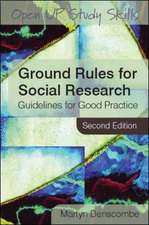Applied Multivariate Analysis
Autor Ira H. Bernstein Cu Calvin P. Garbin, Gary K. Tengen Limba Engleză Paperback – 21 oct 2011
Preț: 651.84 lei
Preț vechi: 766.87 lei
-15% Nou
Puncte Express: 978
Preț estimativ în valută:
124.77€ • 135.57$ • 104.87£
124.77€ • 135.57$ • 104.87£
Carte tipărită la comandă
Livrare economică 21 aprilie-05 mai
Preluare comenzi: 021 569.72.76
Specificații
ISBN-13: 9781461387428
ISBN-10: 1461387426
Pagini: 532
Ilustrații: XIX, 508 p.
Dimensiuni: 155 x 235 x 28 mm
Greutate: 0.74 kg
Ediția:Softcover reprint of the original 1st ed. 1988
Editura: Springer
Colecția Springer
Locul publicării:New York, NY, United States
ISBN-10: 1461387426
Pagini: 532
Ilustrații: XIX, 508 p.
Dimensiuni: 155 x 235 x 28 mm
Greutate: 0.74 kg
Ediția:Softcover reprint of the original 1st ed. 1988
Editura: Springer
Colecția Springer
Locul publicării:New York, NY, United States
Public țintă
ResearchCuprins
1 Introduction and Preview.- Overview.- Multivariate Analysis: A Broad Definition.- Multivariate Analysis: A Narrow Definition.- Some Important Themes.- The Role of Computers in Multivariate Analysis.- Choosing a Computer Package.- Problems in the Use of Computer Packages.- 2 Some Basic Statistical Concepts.- Overview.- Univariate Data Analysis.- Bivariate Data Analysis.- Statistical Control: A First Look at Multivariate Relations.- 3 Some Matrix Concepts.- Overview.- Basic Definitions.- Basic Matrix Operations.- An Application of Matrix Algebra.- More about Linear Combinations.- Eigenvalues and Eigenvectors.- 4 Multiple Regression and Correlation—Part 1. Basic concepts.- Overview.- Assumptions Underlying Multiple Regression.- Basic Goals of Regression Analysis.- The Case of Two Predictors.- The Case of More Than Two Predictors.- Inferential Tests.- Evaluating Alternative Equations.- Example 1—Perfect Prediction.- Example 2—Imperfect Prediction plus a Look at Residuals.- Example 3—Real Personality Assessment Data.- Alternative Approaches to Data Aggregation.- 5 Multiple Regression and Correlation—Part 2. Advanced Applications.- Overview.- Nonquantitative Variables.- The Simple Analysis of Variance (ANOVA).- Multiple Comparisons.- Evaluation of Quantitative Relations.- The Two-Way ANOVA.- The Analysis of Covariance (ANCOVA).- Repeated Measures, Blocked and Matched Designs.- Higher-Order Designs.- 6 Exploratory Factor Analysis.- Overview.- The Basic Factor Analytic Model.- Common Uses of Factor Analysis.- An Overview of the Exploratory Factoring Process.- Principal Components.- Factor Definition and Rotation.- The Common Factor Model.- An Example of the Common Factor Model.- Factor Scores.- Addendum: Constructing Correlation Matrices with a Desired FactorStructure.- 7 Confirmatory Factor Analysis.- Overview.- Comparing Factor Structures.- Oblique Multiple Groups Tests of Weak Structure.- LISREL Tests of Weak Substantive Models.- LISREL Tests of Strong Substantive Models.- Causal Models and Path Analysis.- Causal Models and LISREL.- Addendum: A Program to Obtain Oblique Multiple Groups Solutions.- 8 Classification Methods—Part 1. Forming Discriminant Axes.- Overview.- Discriminant Analysis with Two Groups and Two Predictors.- Discriminant Analysis with Two Predictors and Three Groups.- Discriminant Analysis—The General Case.- 9 Classification Methods—Part 2. Methods of Assignment.- Overview.- The Equal Variance Gaussian Model.- The Unequal Variance Gaussian Model.- Other Signal Detection Models.- Strategies for Individual Classification.- Alternative Strategies—An Overview.- A Numerical Example.- Classification Based on Salient Variables.- Discriminant Functions and Classification.- Classification Based on Distance Measures.- A Summary of Strategic Considerations in Classification.- 10 Classification Methods—Part 3. Inferential Considerations in the Manova.- Overview.- The Two-Group MANOVA and Hotelling’s T2.- Tests of Vector Means with Multiple Groups.- The Simple MANOVA with Multiple Groups.- The Multivariate MANOVA.- The MANCOVA.- 11 Profile and Canonical Analysis.- Overview.- Profile Similarity.- Simple and Hierarchical Clustering.- Canonical Analysis.- 12 Analysis of Scales.- Overview.- Properties of Individual Items.- Test Reliability.- Numerical Example I: A Unifactor Scale.- Numerical Example II: A Two-Factor Scale.- Test Validity.- Appendix A—Tables of the Normal Curve.- Appendix D—Tables of Orthogonal Polynomial Coefficients.- Problems.- References.- Author Index.
















